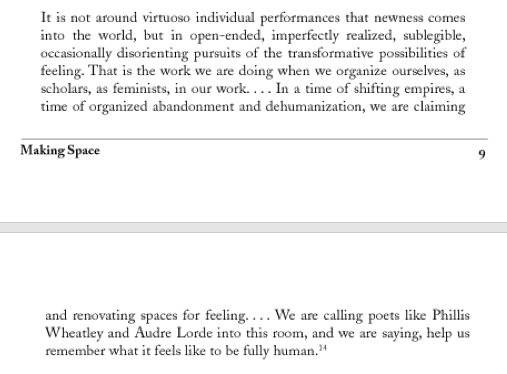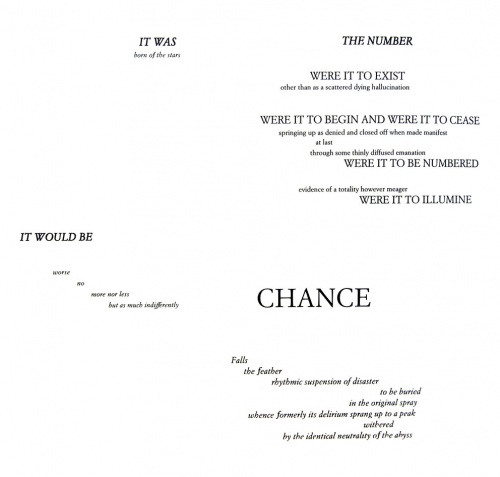User:Inge Hoonte/Thesis Research: Difference between revisions
Inge Hoonte (talk | contribs) No edit summary |
Inge Hoonte (talk | contribs) No edit summary |
||
| Line 11: | Line 11: | ||
[[File:mallarme.jpg|500px]] | [[File:mallarme.jpg|500px]] | ||
Stéphane Mallarmé, Un coup de dés jamais n’abolira le hasard (A throw of the dice never will abolish chance). 1897 | Stéphane Mallarmé, Un coup de dés jamais n’abolira le hasard (A throw of the dice never will abolish chance). 1897 | ||
Via: artintelligence.net | Via: artintelligence.net | ||
==Nice pictures== | ==Nice pictures== | ||
[[File:abstract_notions.png]] | [[File:abstract_notions.png]] | ||
Revision as of 17:01, 30 October 2011
Sunday, Oct 30, thinking about collaborative, participatory practices, improvisation, open-ended outcomes departing from set guidelines, nonlinearity
I'm working on the invite text for the 11:11:11 project that I'm working on with Birgit. Was asked to fill out a questionnaire about my involvement in the project, questions on collaborative, online performance. We had our rehearsal on Friday, and once again, I remembered why I love improvisation within some outline or set structure. We knew how we wanted to structure the space, with the Proprietary/Free Software apartment in the back of the room, and the projection on the other side, so the actors can see themselves and interact with the avatars better. Overall, the platform hasn't been super easy to work with. The site is a bit clouded to navigate. We've had a hard time working with the webcam within the stage. Images don't always load which seems to be a server issue on their side. The rehearsal went fine though. It was good for us to test out some ideas and get a better idea of what we want to do on the 11th. I like going with the flow and seeing where things land. The part where I, as an avatar, moved into the webcam screen, and moved my physical body also into the stream, was SUPER. My avatar hands became real hands, the story connected.
Today, while working through unread emails, I find myself thinking about collaborative, participatory practices, and researching some terms in the field of networked media that I should probably know, or have heard of but don't really know how to explain. Trying to get a better understanding of how what I do relates to being here, learning here, and developing myself the coming years.
The journey started with reading on common practice- a project to write collaboratively, a link that Aymeric sent me in relation to my research on nonlinear textuality. This led me to reading Aymeric's recent text on free software. (more on GNU's Not Unix here) Use of copy-left terminology in 1960s by mail-artist Ray Johnson. "(...) under the 1976 copyright act, the only recognised artistic collaborative work was the joint work, in which it is required that all the authors agree that all their contributions are meant to be merged into one, flattened down, work. This made perfect sense in the context of the print based copyright doctrine but was clearly not working for digital environments where the romantic vision of the author is dissolved in the complex network of branches, copies and processes inherent to networked collaboration." About process of developing work, not just final product.
Mentions Raymond Queneau, cofounder OuLiPo-- cent mille milliards de poèmes --- would be interesting "import random" type of python poetry generator. Bev Rowes' html generator of Queneau. Wikipedia: "When Queneau ran into trouble while writing the poem(s), he solicited the help of mathematician Francois Le Lionnais, and in the process they initiated Oulipo.[1]" [1]:
Graham Coulter Smith on nonlinearity "a mode of narrative less concerned with storytelling and more preoccupied with the process of establishing connections, associations and transformations." On Mallarmé: "abstract in the sense that it transcends commonsense"
Stéphane Mallarmé, Un coup de dés jamais n’abolira le hasard (A throw of the dice never will abolish chance). 1897 Via: artintelligence.net
Nice pictures
Museum of Jurassic Technology
Write up on a blog
(Via Amy)
Mr. Wilson's cabinet of wonder, Pronged Ants, Horned Humans, Mice on Toast, and Other Marvels of Jurassic Technology, Lawrence Weschler - from googlebooks: "Pronged ants, horned humans, a landscape carved on a fruit pit--some of the displays in David Wilson's Museum of Jurassic Technology are hoaxes. But which ones? As he guides readers through an intellectual hall of mirrors, Lawrence Weschler revisits the 16th-century "wonder cabinets" that were the first museums and compels readers to examine the imaginative origins of both art and science. Illustrations."
Museums and Memory, Susan A. Crane, Stanford University press 2000
Geoffrey Sonnabend: Memory is an illusion. Just a human fabrication to deal with fleeting life and irretrieveability of moments and events. Memories are artificial constructions built on experiences that we attempt to make live again by infusions of imaginations. He questions all memory: "there is only experience and its decay," rendering short term memory as the decay of an experience. He was obsessed with how experiences decayed. He created the Model of Obliscence (model of forgetting), in which shapes and forms represent the various attributes that contribute to the process of forgetting. Basically, the Cone of Obliscence intersects the Plane of Experience, which is always in motion. Their intersection is called the Spelean Disc.
The Cult of Remembrance - Paula Findlen
Theatrical Jazz Aesthetic
the bull-jean stories Theater adaptation from the novel by Sharon Bridgforth. Set in the 1920s, rural Southern US. Stories about love, stories about women loving women. The Dallas-based actress Q-Roc Ragsdale plays all male and female roles in this play, and also produced the video shorts in which other parts of the play come to life. Author Bridgforth called her book love conjure/bluesa 'performance novel,' and she writes in the jazz aesthetic.
Researching this through their communally published book Experiments in a Jazz Aesthetic, from which the following is largely quoted. the Jazz Aesthetic is an African American art creation, emerging in the 1970s in Harlem, NY. From Omi: "Theatrical jazz aesthetics began to form in the early 1970s alongside the Black Arts Movement in the Sounds in Motion Harlem dance studio under the tutelage of Dianne McIntyre." more here
the Austin Project (tAP) -> women-only group for creative research and practice, initiated by Omi Osun Joni L. Jones: a place where she was pushed to unearth the moldy, dank places of fear, and to fully be. "I realize now that these places of fear were born of the rejection I had come to think of as the expected response to my very existence." Meetings, writing workshops, performances, creative flow.
jazz practice (pretty much a straight quote from Jones' chapter on tAP) evolved in a manifesto for tAP:
- Be present. Bring your full self, feel exactly what you feel right now.
- Breathe. Take life fully into the body.
- Listen. Deep listening.
- Improvise. Spontaneous creation requires courage and dexterity. The skills of listening and being present are essential.
- Simultaneous truths. Jazz aesthetics rely on the ability to imagine more than one event, sound, or idea at a time. This is competition, synthesis, chaos. The work encourages layering of images, ideas, sound, experience. POLYPHONY AND MULTIVOCALITY ARE MANDATORY.
- Collaboration. Working with others insists on individual clarity and humility. It rests on the belief that individuals learn themselves more fully in interaction with others, and that there is virtue in collective power. Choral work enhances vibrancy.
- Virtuosity. It is an individual's responsibility to bring forth her specific and idiosyncratic self into the world. The vocalizations, the gestures, the thinking, and the beauty are honed through repeated experiences that support solo gifts and the development of a personal voice.
- Body-centered. Jazz aesthetics recognize the body as a site of knowledge. Cellular learning is linked to emotional and intellectual learning. Memory and daily living are lodged in the muscles, and must be restructured to ensure the radical reality of joy and health. Shifting these visceral knowledge systems generates social change. Experience is passed on, person to person.
- Metamorphosis. Repeated practice of these principles changes spirit and thinking and behavior and knowledge. This is the basis for the formation of a just, humane community.
Look up: Katherine McKittrick: geographies of domination.
Pedagogical Strategy within tAP: we learn by doing and creating, we model strength, courage and innovation for each other. Mostly working with women of color. One or two white women also attending, have to earn the privilege to be there, unlike their daily white privilege elsewhere. Other way around, women of color would be stimulated and empowered by their presence.
Habit of Freedom: activism on a daily basis. Very much aimed at how do you apply what you learn and practice at tAP, everywhere. Joanna Brooks:

Conscientious regard for feelings: how the women in tAP conceive of themselves and their relations with others. Prerequisite for social change. Theresa Jenoure: "[personal discovery] necessitates our moving in closer to the center of ourselves and coming to terms with deep-rooted impulses. Embarking on an introspective path, but ultimately working toward the full, healthy function of the group, we need to evaluate our own strengths and weaknesses on an ongoing basis, using everything we produce as a barometer for growth."
To get at the deepest of unconscious, and therefor insidiously entrenched habits, there must be focused attention on the body, the repository of all experience. In tAP, the women are encouraged to write the truths their bodies have been terrorized into keeping silent.
Space: not only for creation of art but creation of a truly authentic life.
Finding Voice - Sharon Bridgforth
Inspiring writing style. Flow.
Unmask, unleash, reveal spirit to be able to hear more deeply and better able to create collaboratively. The jazz aesthetic is female in its creative energy. Her writing workshop Finding Voice has worked best among a circle of women who write, mostly of color, some queer (variations work also). The method is based on the process of writing and is generative. VIRTUOSITY, IMPROVISATION, BEING PRESENT, LISTENING, WITNESSING, EXPANSION AND EXPLORATION OF TIME, POLYRHYTHMS, NON-LINEAR FORMS, BREATH, SYNCHRONICITY, AND TRANSCENDENCE. It is about walking with people as they journey into a deep place in themselves for the sake of artistic expression. Ask questions. Encourage people to ask questions. Be honest and clear when inviting or not inviting people! Includes instructions on how to facilitate such a workshop. More programs and notes available.
Cern: art&science residency
(Sidetracked with Amy in mind)
A laboratory of the imagination. Currently, there are three ways to combine art & science:
- art as a communicator of science
- science as a means of art production
- science as art
And more subtly:
- art and science in a fluid interchange: oscillations between sameness and differences. Both are driven by curiosity, discovery, the aspiration for knowledge of the world or oneself. But they express themselves in different ways: the arts through the body and mind, often driven by the exploration of the ego, contradictions and the sheer messiness of life; science through equations, directed, collaborative research and experimentation that works in a progressive, linear fashion. As Dr Michael Doser, the experimental physicist on Cern's cultural board for the arts, says: “What I find wonderful about working with artists is that they are just as fascinated by side routes and diversions as they are by the direction in which they are going. This is what makes artistic work really different from scientific work.”
Mariko Mori: A space for connection: "Drawing upon the Buddhist principle that all forms of life in the universe are interconnected, Wave UFO seamlessly united actual individual physical experience with Mori's singular vision of a cosmic dream world. Within the tranquil interior of the work, Mori sent participants, three at a time, on an aesthetic voyage that sought to connect three individuals to each other and to the world at large. "



